Practical Boat Owner
- Digital edition


“How I sailed around the world in my 32ft yacht”
- Jeremy Bagshaw
- February 15, 2024
The fifth finisher in the 2022 Golden Globe Race, Jeremy Bagshaw shares how he prepared his OE32 for a non-stop circumnavigation alone

At 32ft, Olleanna was the smallest boat in the 2022 Golden Globe Race fleet, but had the second longest waterline and was one of just five boats to finish. Credit: GGR2022/DD&JJ Credit: GGR2022/DD&JJ
How to sail around the world in a 32ft yacht
She was one of the saddest boats I’d ever seen, but her lines were beautiful.
Olleanna , an Olle Enderlein-designed OE 32 with a dark blue hull, caught my eye in a way that few boats ever have; it was love at first sight as I stared down at her from the dock at the Royal Cape Yacht Club in Cape Town.
In South Africa, we don’t see a lot of foreign designs other than the run-of-the-mill French production boats from Beneteau , Dufour and Jeanneau, so Olleanna stood out.
I started asking around and found she’d been entered in the 2018 Golden Globe Race by her Norwegian owner and skipper, Are Wiig.
Are was in fourth position in the race when he suffered a knockdown and capsized around 400 miles south-west of Cape Town.

Are Wiig sailed 400 miles under jury rig to Cape Town after Olleanna was dismasted in the 2018 Golden Globe Race. Credit: Eban Human/PPL/GGR
He was dismasted and the coachroof was damaged by the falling rig. He managed to erect a jury rig using twin spinnaker poles and sail unassisted to Cape Town showing true seamanship.
On arrival, she was eventually purchased by a local boatbuilder who repaired the structural damage and stepped a new rig.
It was at this stage I stumbled across her and the seeds of an adventure were planted in my mind!
It wasn’t long before I was researching the design and how Are had fared in the build-up to the Golden Globe Race and the first 8,000 miles of the race.
He’d sailed Olleanna up to the edge of the Arctic Circle and had set a record time for the return leg south along the Norwegian coast.
Over 200 hulls have been built in Denmark and Sweden since 1971 – Olleanna was Swedish-built in 1973 – and some of them had done remarkable voyages in the North Atlantic giving credibility to the legendary sea-keeping attributes of the design.
Craftsmanship
The Olle Enderlein 32 is a full keel , cutter-rigged cruising boat with the rudder hung off the trailing edge of the keel below a ‘North Sea transom’ sometimes more commonly known as a double-ender.
She has a generous waterline length of 8.38m (27ft 6in) on a length overall of 9.89m (32ft 5in) and a decent sail area/displacement ratio of 14.48 indicating a forgiving rig that is neither under nor overpowered for cruising.

The rudder of the OE32 is hung off the trailing edge of the keel below her North Sea transom. Credit: Katy Stickland
Displacement of a little over 6,200kg puts her on the heavier side of equivalent-length modern production boats but this is a comforting factor given the more severe weather conditions that will inevitably be encountered on a circumnavigation as opposed to coastal and short hop cruising that modern production boats of this size are designed for.
The designer hit a sweet spot with this boat and created a wonderful balance between performance in all weather conditions, comfortable sea-keeping qualities, seaworthiness and roominess below decks.
The best route to sail around the world
The route of my circumnavigation was the traditional tradewind route from west to east.
I departed from Les Sables d’Olonne, France, and sailed back there some 278 days later via the three Great Capes – Good Hope, Leeuwin and Horn.
As part of the race route, we needed to pass check-in points at Lanzarote, Cape Town and Hobart; we also had to leave Isla Trinidade to port, latitude 44°S to starboard while in the Indian Ocean and latitude 47°S to starboard in the Pacific Ocean, with a few modifications to allow rounding of Cape Horn at 56°S.
An early September start in France gives a small-boat sailor the best chance of passing into the Southern Ocean in the Austral summer and of rounding Cape Horn before the Austral autumn – and the greater possibility of inclement weather – sets in.

All halyards and reefing were at the mast. A basket kept the line tails stowed. Credit: Macmedia2021/Simon McDonnell
The first two months of the voyage were spent in mainly summery weather as we traversed the temperate and tropical regions with some tradewind conditions, but also a lot of squally tropical weather.
The voyager needs to be prepared for conditions that frequently change in direction and intensity. This requires a conservative approach to sail selection and watchkeeping strategy to minimise the risk of damage to the boat and sails.
After entering the South Atlantic, the effects of the constant west-east flow of air means that while conditions are more predictable, they are also more extreme.
Passage planning in this region is all about weighing up the pros and cons of sailing a shorter distance with bigger weather at higher latitudes versus warmer and probably milder conditions in the temperate zones with a good chance of contrary (easterly) winds.
Prepare for success
When planning to undertake any ocean passage, the better your preparation, the more enjoyable the sail is likely to be.
For a circumnavigation, and in my case a non-stop one, preparation was paramount given that I needed to be completely self-sufficient for 30,000 miles.
While I admittedly prepared my boat with a round-the-world race in mind, I accept that other sailors may have a different philosophy.
But having been one of only six starters out of 16 to finish, I believe that preparing a boat for racing may be a very good standard to work towards, even when you only intend to cruise.
When I bought Olleanna in December 2019 she was still showing all the signs of a boat that had suffered a knockdown and capsize, damage to the deck and serious water ingress .
I realized that I had a mountain to climb in terms of the refit.
My choice of boat was limited by a few factors, among them being affordability, availability and compliance with the 2022 Golden Globe Notice of Race.

Jeremy did a lot of the refit work himself. The yacht had a new Sparcraft mast. Credit: Jeremy Bagshaw
The OE 32 fitted neatly into the race requirements, albeit on the lower end of all the parameters.
I took some comfort in the fact that Suhaili , Robin Knox-Johnston ’s boat in the 1968 event, was also 32ft LOA although Suhaili displaced considerably more.
I also researched the causes of Olleanna ’s dismasting and after chatting to her previous owner, Are, I was comfortable that he’d been incredibly unlucky with a set of circumstances that conspired to knock him down in ‘one in a million’ conditions.
I was confident that I’d chosen a design that was fast enough to be competitive and robust and seaworthy enough to see me safely around the globe.
Olleanna ’s refit forced me to look at some of the conventionally accepted norms, especially in terms of sizing, durability, complexity and cost of equipment.

Olleanna ’s saloon, just days before the start of the 2022 Golden Globe Race; tennis net is to dry wet gear, act as another handhold and prevent objects sliding around the saloon floor. Credit: Katy Stickland
Upfront I decided to avoid cutting-edge new technology, anything I couldn’t either repair myself or do without if I wasn’t able to repair it.
I decided to over-size what I could without affecting the overall performance and to add strength to the deck and rig components wherever I could.
The second decision I made, which with the benefit of hindsight was critically important, was to introduce as much redundancy into every system as possible.
I tried to ensure that there was no way that the failure of a single component in a critical system would lead to the complete failure of the system.
A second pair of hands
Without a doubt, the most crucial part of passage making, especially for a solo sailor, is self-steering ; it is invaluable.
The correct system for your boat will steer 24 hours a day in all conditions, freeing the skipper up to get enough rest, keep well fed, keep a good lookout when necessary, attend to navigation, maintenance and a myriad of other tasks that need addressing daily on board.
The Golden Globe Race rules permitted only the use of windvane self-steering systems in keeping with the ethos of the original 1968 race.
There are several windvane self-steering manufacturers but competitors needed to submit reasons for selecting one that was not on the approved list.
There were two elements to this process.

Windpilot Pacific kit. Credit: Jeremy Bagshaw
Cynics might say the fact one manufacturer of an approved system was also a race sponsor had something to do with this, but the reality is that the 2018 race proved beyond doubt that some manufacturers produce more robust systems suited to the rigours of a non-stop circumnavigation than others.
The failure of self-steering systems was the single biggest contributor to retirements in both the 2018 and 2022 events.
Windvane self-steering systems can be roughly divided into two categories; those units that steer the vessel using the vessel’s rudder by means of a servo-pendulum arm, and those that steer the vessel using an auxiliary rudder while the vessel’s rudder is fixed in position to compensate for lee or weather helm.
Both systems have their pros and cons and some are more suited to certain transom types and boat handling characteristics than others, so choosing the best system for your boat is not always a simple matter.
I selected a Windpilot Pacific unit for Olleanna for a few reasons: it’s a relatively light system weighing in at 20kg excluding the bracket I had manufactured to attach it; the entire unit is accessible from the deck and there is no need to climb over the transom to repair or service any part of the unit.

The only damage to Jeremy’s Windpilot Pacific self-steering gear was two broken plywood windvanes, which were easily replaced. Credit: Jeremy Bagshaw
It’s a servo-pendulum system that uses the vessel’s rudder (with a large surface area) to steer the boat; it is an intrinsically simple but robust unit with few parts that could fail; it is a simple matter to replace or repair any part in the safety of the vessel’s cabin by removing the whole unit by releasing two bolts; in the event of a knockdown, the servo-pendulum arm does not come up against stops and potentially break, but rather can swing through a very large arc unhindered; it is incredibly powerful, exerting some 200kg force at the tiller enabling it to cope with enormous loads.
With the benefit of having sailed with the Windpilot for over 40,000 miles in 14 months, I can confidently say it was one of the best decisions I made.
The unit steered perfectly in all conditions (except for drifting conditions with a big swell), even when I was forced to sail under bare poles for up to 48 hours at a time.
The only damage I suffered was two broken plywood windvanes when extra large waves smashed over the stern and it was a two-minute job to replace the blades with spares!
Rig and standing rigging to sail around the world
While it’s possible to improvise in many cases of gear failure and to continue sailing without too much inconvenience, the loss of a rig usually spells the end of the voyage.
At best you can set up a jury rig from leftover pieces of spars, at worst you may need to be rescued.
With this in mind, I was very diligent with Olleanna ’s rig. I was fortunate in that after Are’s dismasting, the next owner purchased a well-specified section from Sparcraft Cape Town.
I went to chat with the extremely knowledgeable engineers there and together we decided on some enhancements that could make an already strong rig even stronger and more suitable for my circumnavigation.

A displacement of just over 6,200kg makes Olleanna less prone to weather-induced damage than lighter, equivalent-length modern production boats. Credit: Macmedia2021/Simon McDonnell
The cap shroud attachment points were changed from conventional ‘T-ball’ slots to bolted-through and welded tangs that took appropriately sized fork fittings.
The forestay tang was upsized and fitted with a stainless steel grommet.
The vulnerable slots that take the forward and aft lowers had doubler plates fitted around them to absorb and spread the load in this area.
In the 2018 race, the eventual winner, Jean-Luc van den Heede, had two of his lower shrouds tear deep grooves into the mast, effectively making the shrouds too long and causing the middle of the mast to be unsupported.
He was able to make a jury rig to repair the worst of the damage.
Avoiding chafe
I specified twin spinnaker pole topping lifts and given the large arc that the lifts potentially travel through, we had a cage fitted to the front of the sheave box to act as a frictionless guide and prevent chafe.
I wanted to have my genoa halyard on a rack to relieve pressure on a clutch or other cleating arrangement and also to prevent having a whole halyard floating around the foredeck and serving no purpose.
We decided to go with a wire halyard and so replaced the traditional halyard sheave with one for use with a wire halyard.
Sparcraft also suggested reinforcing the gooseneck fitting and through bolting the running backstay attachment points at the second spreaders.

The Watt & Sea hydrogenerator worked well as long as the boat speed was 4 knots or more. Credit: Jeremy Bagshaw
We made up a lighter whisker pole that fitted the foot length of both the staysail and the storm jib rather than using a spinnaker pole with the increased risk associated with trying to manoeuvre a long pole in brisk conditions.
This whisker pole saw many thousands of miles of service in the Southern Ocean.
We also made up oversized spinnaker pole stowage fittings which were bolted to a backing plate below decks.
These fittings were made to be used as the bases for a jury rig as well.
The last enhancement was an idea pinched from modern cruising catamaran rigging. It was a combination step and also a basket to stow all halyard and reefing line tails.

Olleanna had brand new running rigging; only a spinnaker halyard and spinnaker sheet needed replacing during the 32,000-mile race. Credit: JL Lhomond
I decided to keep all halyards and reefing at the mast rather than bring them back to the cockpit and the resulting halyard tails can be hard to keep tidy without a storage solution.
The step also gave me the extra height needed when attaching the main halyard to the head of the mainsail which stacks quite high with five full battens and meant I didn’t need to balance precariously to reach it.
We decided not to have a moveable/adjustable spinnaker pole mast side fitting, opting instead for simplicity and two fixed rings at carefully calculated heights.
I also specified a Profurl roller furler one size up from the manufacturer’s recommended size.
I believe that the combination of all of the above gave me a completely hassle-free rig experience.
There’s always the weakest link in any chain and in my case it was a weld on the forestay stem fitting/chainplate that sheared 800 miles from the finish, leaving me unable to fly a genoa or sail upwind in variable conditions with only a staysail.
Cockpit drains
A large part of preparation is anticipating things that could go wrong but are outside your range of experiences.
This is where preparing a cruising boat according to the requirements of a race makes sense.
The regulations have often been formulated from a very broad base of experience in real-world situations.
One of the Golden Globe Race requirements was that the cockpit must be able to drain very quickly if filled by beam or following seas.

Buy the best base, mid and outer clothing layers you can afford. Jeremy wore North Sails Offshore gear and stayed dry in storms. Credit: Riaan Smit
On Olleanna , we exceeded the recommended cockpit drain volume by around 50% which proved to be a good move on the few occasions where I was swamped.
With a boat that does not have a cockpit open to the transom, it is critical to get any excess water back overboard as quickly as possible.
As we all know, one cubic metre of water weighs a ton and even a small cockpit like Olleanna ’s could easily hold 400kg of water which very definitely impacts the boat’s handling at a critical time.
Designed-in redundancy
These are all the systems on Olleanna that were designed to provide backup in the event of failure of a component of the main system.
- Twin mainsheet system: not only does this provide additional control during manoeuvres but it also gives great control over mainsail shape and if one fails, there’s another already in place.
- Watt & Sea hydrogenerator and solar PV system : to keep batteries charged to power onboard systems it’s necessary to have a regular or constant charge. On a circumnavigation, you’re often in areas where there is significant cloud cover or even when there is adequate sunshine, the course you’re sailing (usually west to east) means that the boat’s PV system is often shaded for a large part of the day. To compensate, you can use a towed or transom-mounted hydrogenerator. I used a Watt & Sea 300W Long Leg Cruising unit which kept a steady incoming charge whenever boat speed was 4 knots or more.
- Twin spinnaker poles and pole topping lifts provided redundancy if one was damaged or lost.
- I used twin foreguys (spinnaker pole downhauls) for the same reason. These also doubled up as gybe preventers, attaching quickly and easily to permanently rigged preventer lines on the boom. Twin halyards for spinnakers, genoa and mainsail made changeover an easy and risk-free process.
- I did not have a furling drum on my inner forestay and instead used a hanked-on staysail and storm jib; in the event of a failed furler, I’d still be able to set foresails. This wasn’t always convenient, and changing down from staysail to storm jib usually involved getting pretty cold and occasionally wet!
- A tiller comb was traditionally used on Pilot Cutters and the like to provide another ‘pair of hands’ to hold the tiller when the skipper needed theirs! When sailing short-handed, you can never underestimate the value of being able to leave the helm, even for short periods, to attend to other matters and your self- steering may not always be available to take over. My tiller comb was effectively my third crew member and was used extensively in conditions where the wind was too light for the windvane to be effective when motoring, or when I had my Windpilot off the transom for servicing.
Shelter from the elements
There’s an old saying that ‘it’s easier to stay dry than to get dry’ and this is never more true than in the high latitudes where getting wet can have serious comfort, health and safety consequences. Essential to the principle of staying dry are a few considerations.
- Clothing: get the best gear you can afford. Base, mid and outer layers need to be carefully considered. Merino wool products have become the default gear for base- and mid-layers. Warm and light, they also have the most desirable property of not retaining any body odour! Outer layers are equally important and this technology has advanced hugely in the last decades with many brands using industry-leader Gore-Tex fabric. I used North Sails Offshore gear over South African Core Merino base- and mid-layers and even in the most miserable conditions, I stayed completely dry and warm.
- Footwear: like the head, if your feet are wet and cold the rest of the body will not be comfortable. Choose sailing boots that are high enough to prevent ingress when working in the scuppers, and have good non-slip soles. Make sure they’re a few sizes bigger than your normal deck shoes so they can be slipped on over a couple of pairs of socks in a hurry. Leather looks great, but rubber/plastic uppers are more waterproof and require less maintenance. •
- Spray dodger/hood and cockpit tent : never underestimate the importance of this piece of deck gear. It provides a sheltered spot for you to stay in touch with conditions on deck but without having to subject yourself to the full force of the elements, especially in a smaller boat where the cockpit is naturally more exposed. The cockpit tent enclosure is a wonderful addition to the standard dodger, especially when sailing downwind for extended periods with rain and following seas as it allows you to keep the companionway washboards stowed and airflow and connection with the outside. There are pros and cons to having the spray dodger constructed from fabric over a folding stainless steel frame or from rigid materials like plywood etc. With the benefit of hindsight, I’d opt for the hard construction next time.
- Ventilation: condensation is a real factor in higher latitudes , especially when sailing with more than one crew on board. Mould will develop in every nook and cranny aboard. The key to minimising this is good insulation and decent ventilation.
- Heating: in the higher latitudes it is cold. Managing it for the comfort of the crew can be as simple as dressing with more layers or as sophisticated as installing solid or liquid fuel heaters . In a small boat, space and weight are constant considerations and taking extra fuel for heating can be a challenge. I opted for the simplicity of just wearing more layers and having a very well-insulated sleeping bag – less weight, less to break and no chance of carbon monoxide poisoning.
Sails and running rigging to sail around the world
It may seem obvious but sails are the boat’s engine and consequently a critical component of a successful passage; this often doesn’t hit home until sail damage affects the ability to make proper way.
I paid particular attention to the positioning of reef points on my mainsail and the construction of tack and leech patches where loads are higher than normal.
Essential for me was when using a second reef, the head of the sail should be below the level of the running backstay attachments so I could have both runners tensioned during gybes and tacks.

The tiller comb was effective in light winds. Credit: Katy Stickland
I also decided against a storm trysail but rather had a very deep third reef and this served me well up to around 40 knots apparent.
After that, I was usually under bare poles!
My storm jib saw much active service from around 35 knots apparent when the staysail became too big.
Under triple reefed main and storm jib, Olleanna was reasonably comfortable up to around 40 knots.
I also specified a slightly higher clew on my yankee-styled genoa to give me a better view under the sail from the companionway and a better lead for poling out the sail when going downwind without having to re-route the sheets over the guardwires.

When sailing downwind in bad weather, Jeremy made plenty of use of the cockpit tent. Credit: Jeremy Bagshaw
All little details, but they made sailing easier and safer. I started the race with a brand new set of running rigging .
I replaced every halyard, reefing line and sheet. I kept the set that had around 10,000 miles on it as spares and was very careful to label each line that I removed and replaced so that it would be easy to identify a replacement in a hurry.
As it happened, on the whole 32,000-mile voyage, I replaced only a single spinnaker halyard and a spinnaker sheet that had a small amount of chafe developing .
Communication
Keeping in touch with the outside world during an extended passage has become something we all expect these days.
With everything from HF and VHF radio to satellite communication and Starlink connectivity available at ever more affordable rates, there is not much to debate on this topic.
I could help her by moving my human ballast to leeward. I particularly liked Veronique ’s ability to hold a steady course.
Continues below…

Crashed bow repair: how Abhilash Tomy & his team fixed the boat in time for the 2022 Golden Globe Race
What to do if your boat is damaged just days before a non-stop global circumnavigation? Rupert Holmes reports on how…

“I had a banana for a mast” 300 miles offshore: Lessons learned from a mid-Atlantic knockdown
Golden Globe Race entrant and former Clipper Race skipper Guy Waites suffers mast failure 300 miles from the Azores

How to sail to Australia from the UK in a small boat
Kate and Jonny Harrison dreamed of a round-the-world backpacking tour to Australia – but then their plans took a nautical

Jessica Watson – the real sailor behind the True Spirit film
Whilst the new Netflix True Spirit movie was being filmed, celebrating Jessica Watson's real-life teenage solo, non-stop global circumnavigation, the…
What I can say though, is that as a committed satphone and email aficionado, I was pleasantly surprised at the ease of use and practicality of my old Icom M802 set, which was installed with a backstay antenna and an automatic tuner.
I had no choice in the selection of HF as my primary communication tool as it was part of the race rules, and I was initially quite sceptical as to its usefulness.
But having chatted to shore stations and other yachts over distances of many thousands of miles, free, I can safely say I’m convinced that HF radio has a purpose and a place on board cruising boats today.
Training is key before you sail around the world
Before embarking on a solo voyage where you need to be very self-sufficient, it’s a good idea to brush up on some skills. •
- Celestial navigation : if the boat suffers complete electrical failure, you’ll be glad you took the refresher celestial navigation course. Although we were compelled to use sextants as our sole source of establishing position, it is something I’ll incorporate into my passage making routine in the future.
- Medical: while the chances of picking up viruses out at sea are almost nil, injury is always a possibility. Medical help is probably many days away, so the crew must be proficient in advanced First Aid. Having a good physician on call via satellite phone is another good option and several companies offer this service.
- Mechanical: Although we all put to sea in sailboats, with auxiliary power, it is inconvenient when facing a recalcitrant engine and almost flat batteries! The crew must be able to resolve basic engine issues as this can be the difference between negotiating a tricky safe haven entry and having to stand off a lee shore in foul conditions at the end of a long passage. Muck in a fuel tank will quickly make its way into filters and diesel injectors so the crew should have an intimate knowledge of the vessel’s fuel system.
Is a 32ft monohull an ideal boat to sail around the world with? The boat you have is the best one to circumnavigate with!
If it’s on the smaller side, like a 32-footer, then preparation becomes that much more important.
Smaller boats are more susceptible to weather-induced damage than boats with heavier displacement and longer waterlines but a larger-sized vessel is no guarantee of a successful voyage.
Prepare well, route conservatively, be patient and be respectful of the power of nature and you’ll give yourself the best chance.
Many sailors have successfully circumnavigated in smaller vessels, so don’t let that be a reason to not set out on the voyage of a lifetime.
Enjoy reading How to sail around the world in a 32ft yacht?
A subscription to Practical Boat Owner magazine costs around 40% less than the cover price .
Print and digital editions are available through Magazines Direct – where you can also find the latest deals .
PBO is packed with information to help you get the most from boat ownership – whether sail or power.
- Take your DIY skills to the next level with trusted advice on boat maintenance and repairs
- Impartial in-depth gear reviews
- Practical cruising tips for making the most of your time afloat
Follow us on Facebook , Instagram, TikTok and Twitter
Great choice! Your favorites are temporarily saved for this session. Sign in to save them permanently, access them on any device, and receive relevant alerts.
- Sailboat Guide
OE 32 is a 32 ′ 5 ″ / 9.9 m monohull sailboat designed by Olle Enderlein and built by Sundsör’s Ship Yard(SWE)/Eggers (GER) between 1973 and 1983.

Rig and Sails
Auxilary power, accomodations, calculations.
The theoretical maximum speed that a displacement hull can move efficiently through the water is determined by it's waterline length and displacement. It may be unable to reach this speed if the boat is underpowered or heavily loaded, though it may exceed this speed given enough power. Read more.
Classic hull speed formula:
Hull Speed = 1.34 x √LWL
Max Speed/Length ratio = 8.26 ÷ Displacement/Length ratio .311 Hull Speed = Max Speed/Length ratio x √LWL
Sail Area / Displacement Ratio
A measure of the power of the sails relative to the weight of the boat. The higher the number, the higher the performance, but the harder the boat will be to handle. This ratio is a "non-dimensional" value that facilitates comparisons between boats of different types and sizes. Read more.
SA/D = SA ÷ (D ÷ 64) 2/3
- SA : Sail area in square feet, derived by adding the mainsail area to 100% of the foretriangle area (the lateral area above the deck between the mast and the forestay).
- D : Displacement in pounds.
Ballast / Displacement Ratio
A measure of the stability of a boat's hull that suggests how well a monohull will stand up to its sails. The ballast displacement ratio indicates how much of the weight of a boat is placed for maximum stability against capsizing and is an indicator of stiffness and resistance to capsize.
Ballast / Displacement * 100
Displacement / Length Ratio
A measure of the weight of the boat relative to it's length at the waterline. The higher a boat’s D/L ratio, the more easily it will carry a load and the more comfortable its motion will be. The lower a boat's ratio is, the less power it takes to drive the boat to its nominal hull speed or beyond. Read more.
D/L = (D ÷ 2240) ÷ (0.01 x LWL)³
- D: Displacement of the boat in pounds.
- LWL: Waterline length in feet
Comfort Ratio
This ratio assess how quickly and abruptly a boat’s hull reacts to waves in a significant seaway, these being the elements of a boat’s motion most likely to cause seasickness. Read more.
Comfort ratio = D ÷ (.65 x (.7 LWL + .3 LOA) x Beam 1.33 )
- D: Displacement of the boat in pounds
- LOA: Length overall in feet
- Beam: Width of boat at the widest point in feet
Capsize Screening Formula
This formula attempts to indicate whether a given boat might be too wide and light to readily right itself after being overturned in extreme conditions. Read more.
CSV = Beam ÷ ³√(D / 64)
Embed this page on your own website by copying and pasting this code.
- About Sailboat Guide
©2024 Sea Time Tech, LLC
This site is protected by reCAPTCHA and the Google Privacy Policy and Terms of Service apply.
Review of OE 32
Basic specs..
The boat is typically equipped with an inboard Volvo Penta MD11 diesel engine at 23.0 hp (17 kW), which gives a max speed about 5.1 knots.
The fuel tank has a capacity of 180 liters (47 US gallons, 39 imperial gallons).
Sailing characteristics
This section covers widely used rules of thumb to describe the sailing characteristics. Please note that even though the calculations are correct, the interpretation of the results might not be valid for extreme boats.
What is Capsize Screening Formula (CSF)?
The capsize screening value for OE 32 is 1.76, indicating that this boat could - if evaluated by this formula alone - be accepted to participate in ocean races.
What is Theoretical Maximum Hull Speed?
The theoretical maximal speed of a displacement boat of this length is 7.0 knots. The term "Theoretical Maximum Hull Speed" is widely used even though a boat can sail faster. The term shall be interpreted as above the theoretical speed a great additional power is necessary for a small gain in speed.
The immersion rate is defined as the weight required to sink the boat a certain level. The immersion rate for OE 32 is about 180 kg/cm, alternatively 1011 lbs/inch. Meaning: if you load 180 kg cargo on the boat then it will sink 1 cm. Alternatively, if you load 1011 lbs cargo on the boat it will sink 1 inch.
Sailing statistics
This section is statistical comparison with similar boats of the same category. The basis of the following statistical computations is our unique database with more than 26,000 different boat types and 350,000 data points.
What is Motion Comfort Ratio (MCR)?
What is L/B (Length Beam Ratio)?
What is Displacement Length Ratio?
What is SA/D (Sail Area Displacement ratio)?
What is Relative Speed Performance?
Maintenance
Are your sails worn out? You might find your next sail here: Sails for Sale
If you need to renew parts of your running rig and is not quite sure of the dimensions, you may find the estimates computed below useful.
This section shown boat owner's changes, improvements, etc. Here you might find inspiration for your boat.
Do you have changes/improvements you would like to share? Upload a photo and describe what to look for.
We are always looking for new photos. If you can contribute with photos for OE 32 it would be a great help.
If you have any comments to the review, improvement suggestions, or the like, feel free to contact us . Criticism helps us to improve.
The Oe 32 is a 32.45ft masthead sloop designed by Olle Enderlein and built in fiberglass between 1973 and 1983.
200 units have been built..
The Oe 32 is a moderate weight sailboat which is slightly under powered. It is very stable / stiff and has an excellent righting capability if capsized. It is best suited as a bluewater cruising boat. The fuel capacity is originally small. There is a short water supply range.
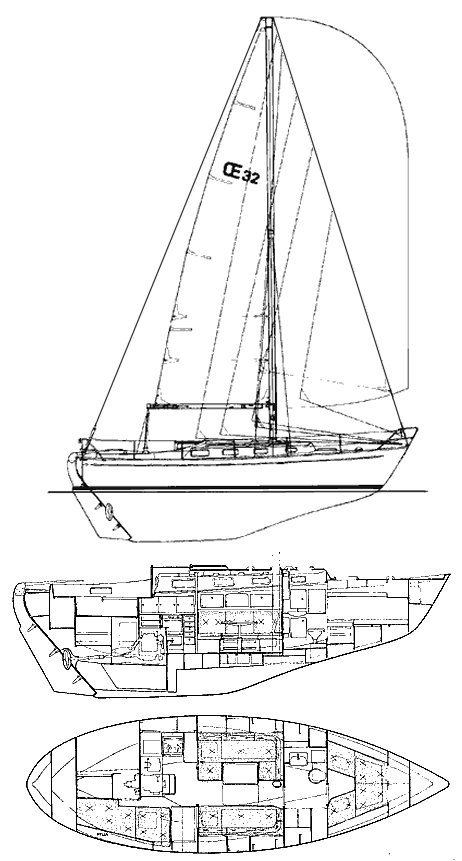
Oe 32 for sale elsewhere on the web:

Main features
Login or register to personnalize this screen.
You will be able to pin external links of your choice.

See how Sailboatlab works in video

We help you build your own hydraulic steering system - Lecomble & Schmitt
Accommodations
Builder data, modal title.
The content of your modal.
Personalize your sailboat data sheet
- Boats for Sale
New and used OE 32 boats for sale
Your search did not find any boats. Here are some suggestions...
- Use the filter form above to widen your search
- Ensure all words are spelled correctly
- Try a new search
- Browse power boats and sailing boats by manufacturer
- Create a Boat Alert to have matching boats emailed to you when they are added
Search all our new or used OE 32 for sale. We have OE 32 brokers and sellers from around the world at great prices.
Sign up to our newsletter
By submitting this form, you agree to our Privacy & Cookie Policy
Change units of measure
This feature requires cookies to be enabled on your browser.
Show price in:
Show lengths, beam and draft in:
Show displacement or weight in:
Show capacity or volume in:
Show speed in:
Show distance in:


Alternatively,
- Register with Facebook
- Register with Google
Why Boatshed?
View all of your boats statistics in real time
Create a virtual "watch" on boats you're interested in
Refer a boat and earn up to 20% of the brokers commission
Language & Currency
Search our catalog, go direct, enter a boat reference, olle enderlein oe32 bermudan sloop, blue-water cruising yacht, £ 0 sold / unavailable.
- Boat REF# · 221143
- Length · 9.89m
- Year · 1990
- Construction · GRP
- Underwater profile · Long Keel
- Sleeping berths · 5
- Engine · 1 x diesel 36hp, Bukh DV36ME (1990)
- Lying · West coast of Scotland.

Boatshed Scotland
This boat is off the market but here are some boats that are still for sale.
- Specification
- Additional Information
Extra Details
New engine mounts - 2014. Oil lubricated stern-gland. Speed-seal water pump cover. Exhaust system renewed 2015. 2 x new service batteries 2016.
Sloop rigged Isomat Aluminium spars (1990) with Stainless Steel standing rigging ()
Recent mainsail with one season's use. Self tacking jib. New UV strip on foresail. Reckmann RS 2000 Furler. Spring-loaded rod kicker. Walden boom brake.
Electrical Systems
12 volt battery, 3 batteries charged by: engine, shore power
Construction
The OE32’s hull was designed with canoe-style transom, a good beam at the water line and an outboard rudder with a tiller. The superstructure is a classic, rugged construction with good height and width. They are solid construction with a hull of hand-laid strong laminate and an encapsulated keel giving excellent stability. The rigging is naturally masthead, as it should be on a long distance sailing boat.
Encapsulated lead-ballast keel. Classic canoe stern with a transom hung rudder. Teak cockpit floor & seating. Treadmaster deck covering. Toughened glass hatches and portlights.
Accommodation
The woodwork offers beautiful full-toned waxed solid teak with rounded corners and bevelled edges. Fine joinery overall and a porcelain washbasin in the heads, with a Simpson Lawrence marine toilet.
Webasto HL32 cabin heating with 3 outlets. Isotherm 3200 refrigerator. Eno 3 burner cooker. A selection of pots & cutlery included.
3 burner propane Stove
3 halyard winches 3 sheet winches Electric Lofrans Anchorman 1000 windlass 3 anchors (Delta, Spade, Fortress) 60.00m of chain Lodestar 280 Airfloor dinghy () (Inflatable) 2hp outboard, Seagull, Short shaft () 2 Andersen halyard winches + 1 reefing winch on mast. 2 Andersen sheet winches in cockpit. 1 furling winch in cockpit. Twin bow rollers. Outboard bracket & lifting davit / crane. New upper guard-wires - 2014. New windlass - 2012. Half cockpit enclosure. Permanent boarding ladder on port quarter.
Nav Equipment
Autohelm 4000 with remote control. Philips Navigator Ap-5 GPS. Garmin GPS. TackTick Log / Depth / Water Temp. Hawk Wind Indicator. A selection of marine charts included.
Safety Equipment
2 bilge pumps (1 manual / 1 electric)
Life-sling. Two fire extinguishers. Portable boarding ladder & Stbd gate.
Broker's Comments
Olle Enderlein designed and built the first OE32 for himself and this one went on to be built by the shipyards of Ulrich Lemke at Sundeved’s Yacht Builders in Sønderborg, Denmark. The OE32 is a classic long-keeler for long voyages, the whole boat is a well-proportioned and timeless beauty. A quality boat from a brand/designer that is renowned for its seaworthiness.
As soon as you step-aboard, the quality of build becomes obvious and this example has also been winter-stored inside the shed and has been maintained to a very high standard. They are built solidly and are well-balanced to sail. From the outset of its design these boats were built for long-distance cruising and they also have extra-thick insulation. For any prospective owner, this would be a yacht to be proud of. She is also the perfect yacht to enter the 2018 Golden Globe 'round the world' ...so you still have plenty of time to prepare!
Pictures taken June 2016.
These boat details are subject to contract. Note: Offers on the asking price may be considered.
Please note this comments section is public . Please do not post your personal details here. Please read our commenting guidelines before posting.
Get Access to More
View unlimited photos of every boat
Walkthrough videos
VR 720° experiences
Get notified of new boats of your interest
Personalised boat recommendations
Save boats to 'My Boatshed'
Cost Of Ownership

- CLASSIFIEDS
- NEWSLETTERS
- SUBMIT NEWS

SPLASH... Are Wiig's Norwegian OE32 yacht 'Olleanna' returns to the water in Asker after a winter preparations for the Golden Globe Race
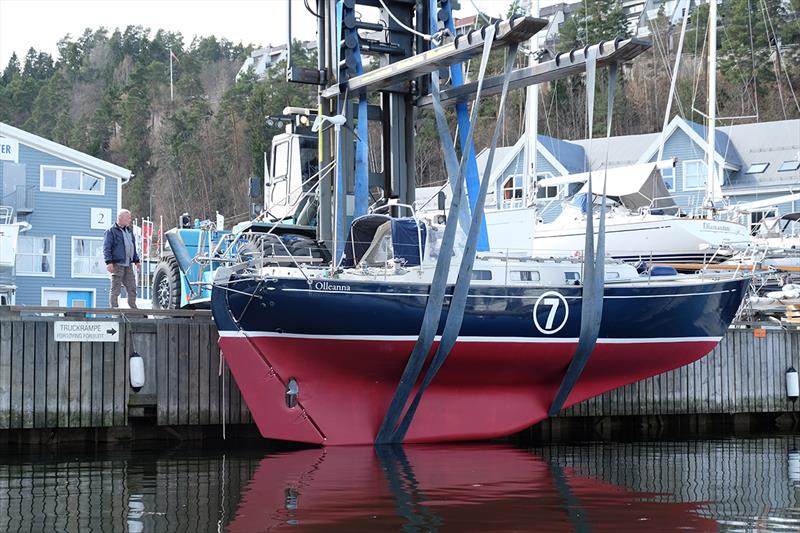

The Comprehensive Guide to Moscow Nightlife
- Posted on April 14, 2018 July 26, 2018
- by Kings of Russia
- 8 minute read
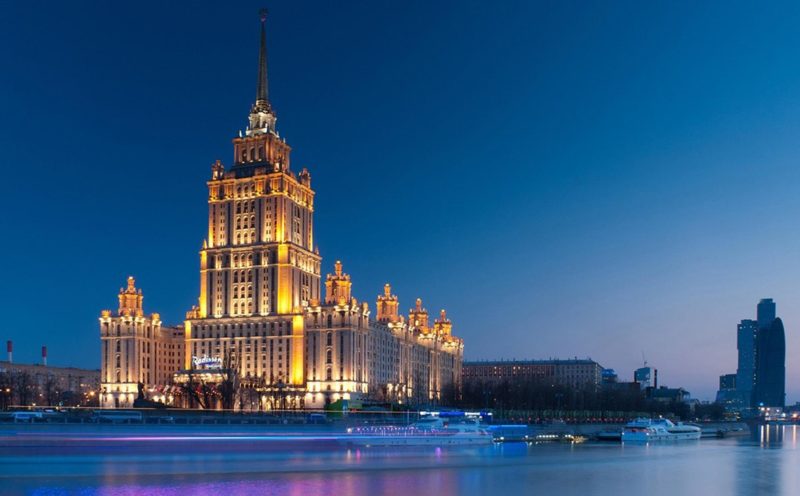
Moscow’s nightlife scene is thriving, and arguably one of the best the world has to offer – top-notch Russian women, coupled with a never-ending list of venues, Moscow has a little bit of something for everyone’s taste. Moscow nightlife is not for the faint of heart – and if you’re coming, you better be ready to go Friday and Saturday night into the early morning.
This comprehensive guide to Moscow nightlife will run you through the nuts and bolts of all you need to know about Moscow’s nightclubs and give you a solid blueprint to operate with during your time in Moscow.
What you need to know before hitting Moscow nightclubs
Prices in moscow nightlife.
Before you head out and start gaming all the sexy Moscow girls , we have to talk money first. Bring plenty because in Moscow you can never bring a big enough bankroll. Remember, you’re the man so making a fuzz of not paying a drink here or there will not go down well.
Luckily most Moscow clubs don’t do cover fees. Some electro clubs will charge 15-20$, depending on their lineup. There’s the odd club with a minimum spend of 20-30$, which you’ll drop on drinks easily. By and large, you can scope out the venues for free, which is a big plus.
Bottle service is a great deal in Moscow. At top-tier clubs, it starts at 1,000$. That’ll go a long way with premium vodka at 250$, especially if you have three or four guys chipping in. Not to mention that it’s a massive status boost for getting girls, especially at high-end clubs.
Without bottle service, you should estimate a budget of 100-150$ per night. That is if you drink a lot and hit the top clubs with the hottest girls. Scale down for less alcohol and more basic places.
Dress code & Face control
Door policy in Moscow is called “face control” and it’s always the guy behind the two gorillas that gives the green light if you’re in or out.
In Moscow nightlife there’s only one rule when it comes to dress codes:
You can never be underdressed.
People dress A LOT sharper than, say, in the US and that goes for both sexes. For high-end clubs, you definitely want to roll with a sharp blazer and a pocket square, not to mention dress shoes in tip-top condition. Those are the minimum requirements to level the playing field vis a vis with other sharply dressed guys that have a lot more money than you do. Unless you plan to hit explicit electro or underground clubs, which have their own dress code, you are always on the money with that style.
Getting in a Moscow club isn’t as hard as it seems: dress sharp, speak English at the door and look like you’re in the mood to spend all that money that you supposedly have (even if you don’t). That will open almost any door in Moscow’s nightlife for you.
Types of Moscow Nightclubs
In Moscow there are four types of clubs with the accompanying female clientele:
High-end clubs:
These are often crossovers between restaurants and clubs with lots of tables and very little space to dance. Heavy accent on bottle service most of the time but you can work the room from the bar as well. The hottest and most expensive girls in Moscow go there. Bring deep pockets and lots of self-confidence and you have a shot at swooping them.
Regular Mid-level clubs:
They probably resemble more what you’re used to in a nightclub: big dancefloors, stages and more space to roam around. Bottle service will make you stand out more but you can also do well without. You can find all types of girls but most will be in the 6-8 range. Your targets should always be the girls drinking and ideally in pairs. It’s impossible not to swoop if your game is at least half-decent.
Basic clubs/dive bars:
Usually spots with very cheap booze and lax face control. If you’re dressed too sharp and speak no Russian, you might attract the wrong type of attention so be vigilant. If you know the local scene you can swoop 6s and 7s almost at will. Usually students and girls from the suburbs.
Electro/underground clubs:
Home of the hipsters and creatives. Parties there don’t mean meeting girls and getting drunk but doing pills and spacing out to the music. Lots of attractive hipster girls if that is your niche. That is its own scene with a different dress code as well.

What time to go out in Moscow
Moscow nightlife starts late. Don’t show up at bars and preparty spots before 11pm because you’ll feel fairly alone. Peak time is between 1am and 3am. That is also the time of Moscow nightlife’s biggest nuisance: concerts by artists you won’t know and who only distract your girls from drinking and being gamed. From 4am to 6am the regular clubs are emptying out but plenty of people, women included, still hit up one of the many afterparty clubs. Those last till well past 10am.
As far as days go: Fridays and Saturdays are peak days. Thursday is an OK day, all other days are fairly weak and you have to know the right venues.
The Ultimate Moscow Nightclub List
Short disclaimer: I didn’t add basic and electro clubs since you’re coming for the girls, not for the music. This list will give you more options than you’ll be able to handle on a weekend.
Preparty – start here at 11PM
Classic restaurant club with lots of tables and a smallish bar and dancefloor. Come here between 11pm and 12am when the concert is over and they start with the actual party. Even early in the night tons of sexy women here, who lean slightly older (25 and up).
The second floor of the Ugolek restaurant is an extra bar with dim lights and house music tunes. Very small and cozy with a slight hipster vibe but generally draws plenty of attractive women too. A bit slower vibe than Valenok.
Very cool, spread-out venue that has a modern library theme. Not always full with people but when it is, it’s brimming with top-tier women. Slow vibe here and better for grabbing contacts and moving on.

High-end: err on the side of being too early rather than too late because of face control.
Secret Room
Probably the top venue at the moment in Moscow . Very small but wildly popular club, which is crammed with tables but always packed. They do parties on Thursdays and Sundays as well. This club has a hip-hop/high-end theme, meaning most girls are gold diggers, IG models, and tattooed hip hop chicks. Very unfavorable logistics because there is almost no room no move inside the club but the party vibe makes it worth it. Strict face control.
Close to Secret Room and with a much more favorable and spacious three-part layout. This place attracts very hot women but also lots of ball busters and fakes that will leave you blue-balled. Come early because after 4am it starts getting empty fast. Electronic music.
A slightly kitsch restaurant club that plays Russian pop and is full of gold diggers, semi-pros, and men from the Caucasus republics. Thursday is the strongest night but that dynamic might be changing since Secret Room opened its doors. You can swoop here but it will be a struggle.

Mid-level: your sweet spot in terms of ease and attractiveness of girls for an average budget.
Started going downwards in 2018 due to lax face control and this might get even worse with the World Cup. In terms of layout one of the best Moscow nightclubs because it’s very big and bottle service gives you a good edge here. Still attracts lots of cute girls with loose morals but plenty of provincial girls (and guys) as well. Swooping is fairly easy here.
I haven’t been at this place in over a year, ever since it started becoming ground zero for drunken teenagers. Similar clientele to Icon but less chic, younger and drunker. Decent mainstream music that attracts plenty of tourists. Girls are easy here as well.
Sort of a Coyote Ugly (the real one in Moscow sucks) with party music and lots of drunken people licking each others’ faces. Very entertaining with the right amount of alcohol and very easy to pull in there. Don’t think about staying sober in here, you’ll hate it.
Artel Bessonitsa/Shakti Terrace
Electronic music club that is sort of a high-end place with an underground clientele and located between the teenager clubs Icon and Gipsy. Very good music but a bit all over the place with their vibe and their branding. You can swoop almost any type of girl here from high-heeled beauty to coked-up hipsters, provided they’re not too sober.
Afterparty: if by 5AM you haven’t pulled, it’s time to move here.
Best afterparty spot in terms of trying to get girls. Pretty much no one is sober in there and savage gorilla game goes a long way. Lots of very hot and slutty-looking girls but it can be hard to tell apart who is looking for dick and who is just on drugs but not interested. If by 9-10am you haven’t pulled, it is probably better to surrender.
The hipster alternative for afterparties, where even more drugs are in play. Plenty of attractive girls there but you have to know how to work this type of club. A nicer atmosphere and better music but if you’re desperate to pull, you’ll probably go to Miks.
Weekday jokers: if you’re on the hunt for some sexy Russian girls during the week, here are two tips to make your life easier.
Chesterfield
Ladies night on Wednesdays means this place gets pretty packed with smashed teenagers and 6s and 7s. Don’t pull out the three-piece suit in here because it’s a “simpler” crowd. Definitely your best shot on Wednesdays.
If you haven’t pulled at Chesterfield, you can throw a Hail Mary and hit up Garage’s Black Music Wednesdays. Fills up really late but there are some cute Black Music groupies in here. Very small club. Thursday through Saturday they do afterparties and you have an excellent shot and swooping girls that are probably high.
Shishas Sferum
This is pretty much your only shot on Mondays and Tuesdays because they offer free or almost free drinks for women. A fairly low-class club where you should watch your drinks. As always the case in Moscow, there will be cute girls here on any day of the week but it’s nowhere near as good as on the weekend.
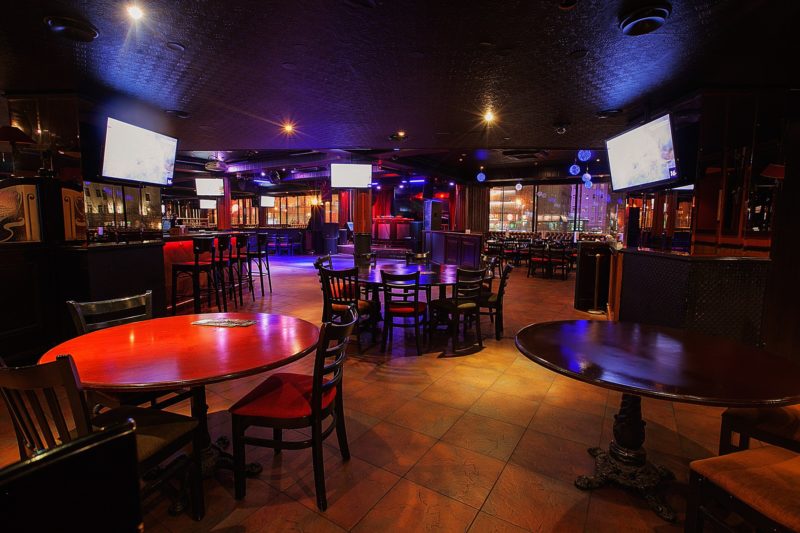
In a nutshell, that is all you need to know about where to meet Moscow girls in nightlife. There are tons of options, and it all depends on what best fits your style, based on the type of girls that you’re looking for.
Related Topics
- moscow girls
- moscow nightlife

The Top 3 Cities in Ukraine for First Timers
- Posted on July 7, 2018 August 4, 2019
You May Also Like
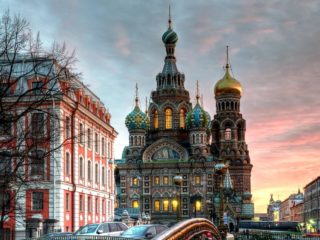
- Uncategorized
The Best Expat Blogs for Moscow
- Posted on May 31, 2020 June 1, 2020

Finding a Russian Bride: How and Where to Meet Her
- Posted on August 9, 2019 August 9, 2019
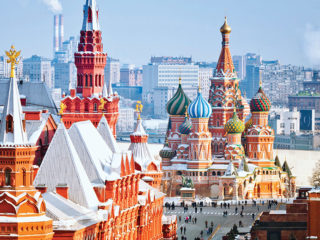
Meeting Women in Moscow: Dating Perspectives on the World’s Most Beautiful Women
- Posted on August 5, 2019 August 9, 2019

Meeting Russian Women: Top 5 Locations
- Posted on August 3, 2019 June 1, 2020
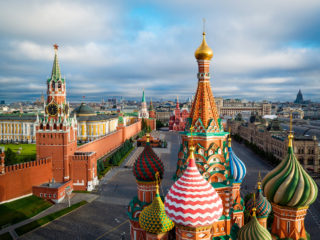
Moscow vs St. Petersburg – Which One to Visit?
- Posted on July 31, 2019 August 3, 2019

Hot Russian Girls – Where to Find & Date Them
- Posted on March 30, 2019 March 30, 2019
A Guide to Teaching English in Russia
- Posted on August 11, 2018 October 9, 2019

How to Attract Russian Girls
- Posted on July 15, 2018 August 4, 2019
Leave a Reply Cancel reply
Your email address will not be published. Required fields are marked *
Input your search keywords and press Enter.

- Remember me Not recommended on shared computers
Forgot your password?
- Payware Airports and Scenery Reviews
Scenery Review : Moscow City XP by Drzewiecki Design
- drzewiecki design

By Stephen September 24, 2016 in Payware Airports and Scenery Reviews
- Reply to this topic
Recommended Posts

You fly for hours, anticipating your arrival, wanting to take in the area and the views of another country far away from your departure airport. The airport and the area you leave from is detailed and visually full, and you know you have a great airport scenery waiting for you at the other end of the flight, then when you arrive...
... Nothing, but flat plain emptiness and the same boring standard X-Plane basic scenery, worse there is no OSM (Open Street Map) data in the tile either, so there is no road or autogen detailing in there as well, just well nothing.
When Drzewiecki Design released their UUEE Sheremetyevo Airport XP , I loved it because it was like a visitor from the Cold War past, the Soviet era, and it was also great scenery and great choice of a destination to fly to from any of the capitals of Europe... but that was it, just this great airport in the middle of nothingness, bland.... zero ville.

Now Drzewiecki Design has released "Moscow City" a scenery package to compliment their UUEE Sheremetyevo, and boy how much a difference this release has done to this totally boring area.
To get the full first impression effect I flew JARDesign's A320neo from EFHK Vatnaa, Helsinki to UUEE Sheremetyevo which is flight Finnair AY153 which is a daily 9.25am service.
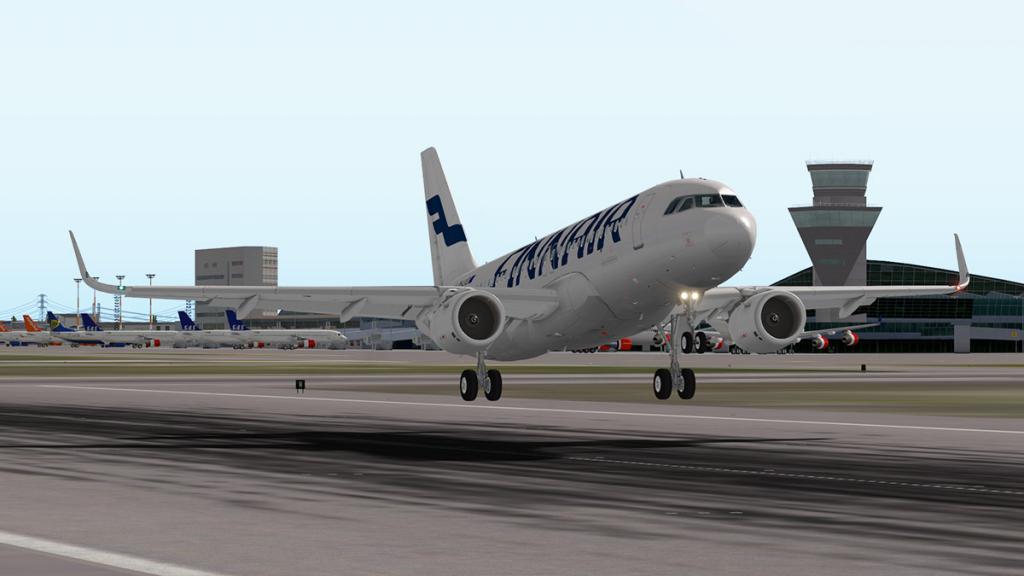
First Impressions
I was surprised to start picking up scenery still quite away out from central Moscow, as I approached my 6000ft transition altitude. Here there was buildings and houses and the physical visual notes you were arriving somewhere.

Looking hard at the horizon through the A320's windows and you could see the iconic silhouette of Moscow city.

The scenery provides lite versions of all Moscow's Airports, this is UUWW Vnukovo, which was easily recognisable as you flew over. As you fly closer to the centre of the city the density of the objects below becomes quite heavy as the landscape fills in. You have all kinds of infrastructure including, blocks of flats, tower blocks, factories, housing, skyscrapers and almost everything that makes up an urban landscape, in all there is 2000 custom-made buildings that makes up this impressive scenery.
A note here in that you don't get that rolling as you move feeling effect where as it just suddenly appears in front of you and then quickly disappears behind as soon as you have flown out over the area. There is a slight effect of that as there has to be, but only in the far distance and as you can see from the images the views in every direction are widespread and visually it is very good to excellent.
The "Seven Sisters" or "Stalinist skyscrapers" built from 1947 to 1953 are all in the scenery with their "Wedding Cake" architecture or officially Russian Baroque - Gothic style. Most famous is the Moscow State University, front and centre of the image below.

Central Moscow is excellent and extremely realistic, and you really need a travel guide to pick out the landmarks and detail, but it is hard to miss the Red Kremlin complex and St Peter's square from the air. Both sides of the aircraft is visually full until you have crossed right over the city.
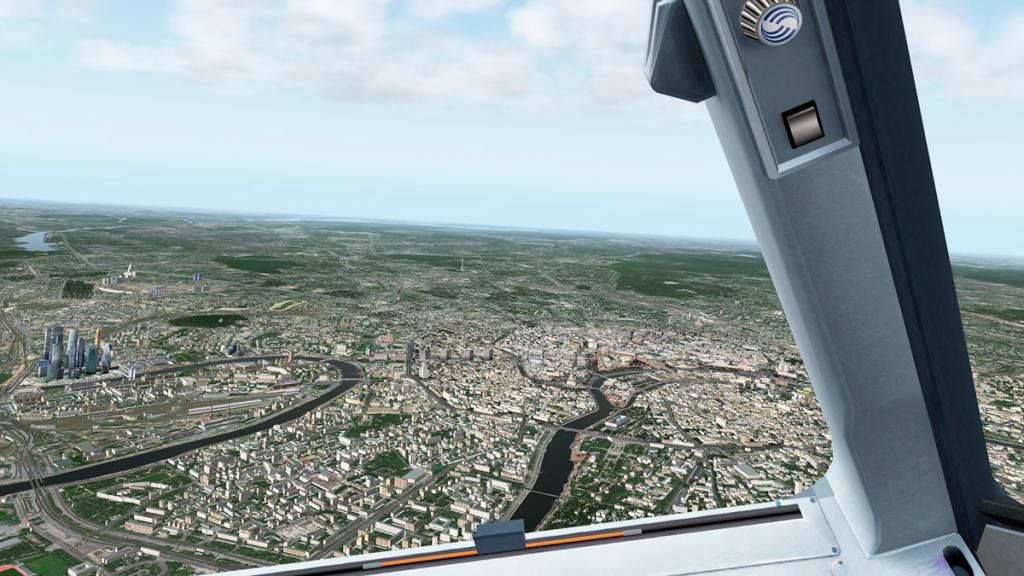
I am not a fan of the generated 3d OSM scenery, but this is very good in blending in perfectly with the X-Plane default scenery and giving you a smooth transition from country to urban and back again with great realism.
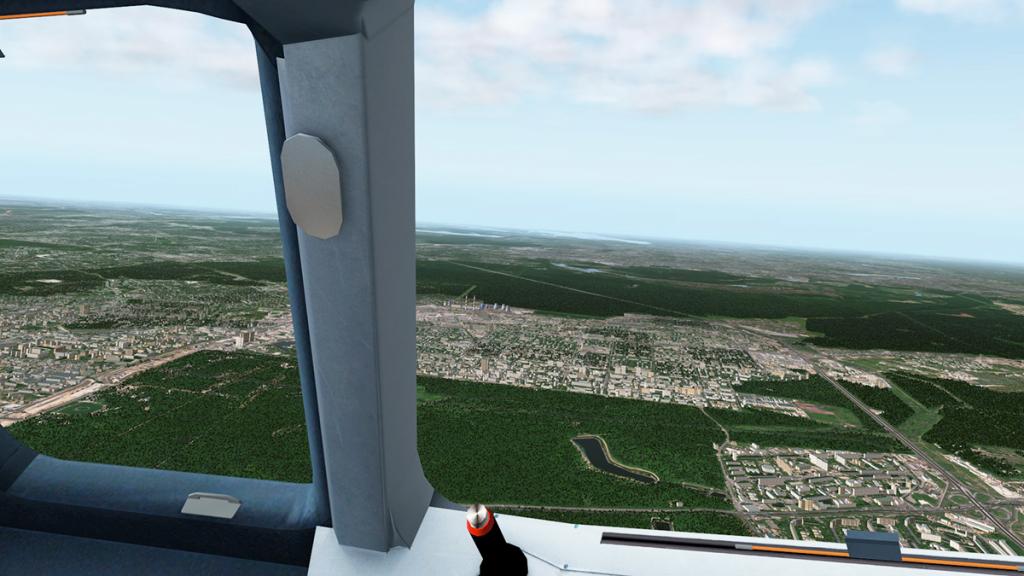
Over the city and turning north towards Sheremetyevo, another Moscow airport UUMU Chkalovsky is represented on the turn.
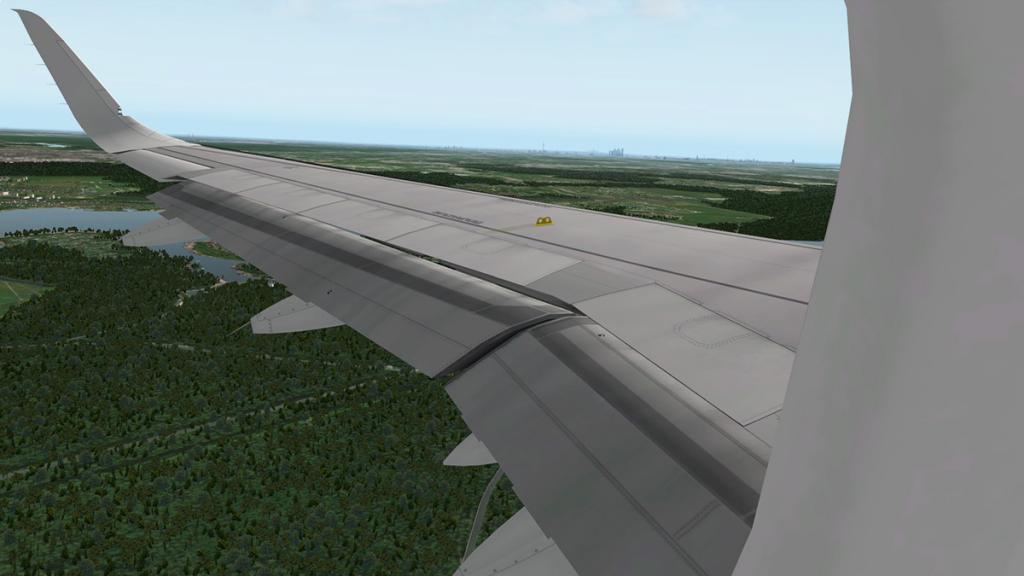
The city skyline is now easily visible on landing at Sheremetyevo, and that really helps in the arrival factor, more so in that the cities building infrastructure spread now comes up and around the airport to fill the gaps to the city itself, and making the original Sheremetyevo scenery that was so open and lonely in the old X-Plane view is now a big part of the whole in this combination. No doubt it really brings this always good scenery now alive and very usable.
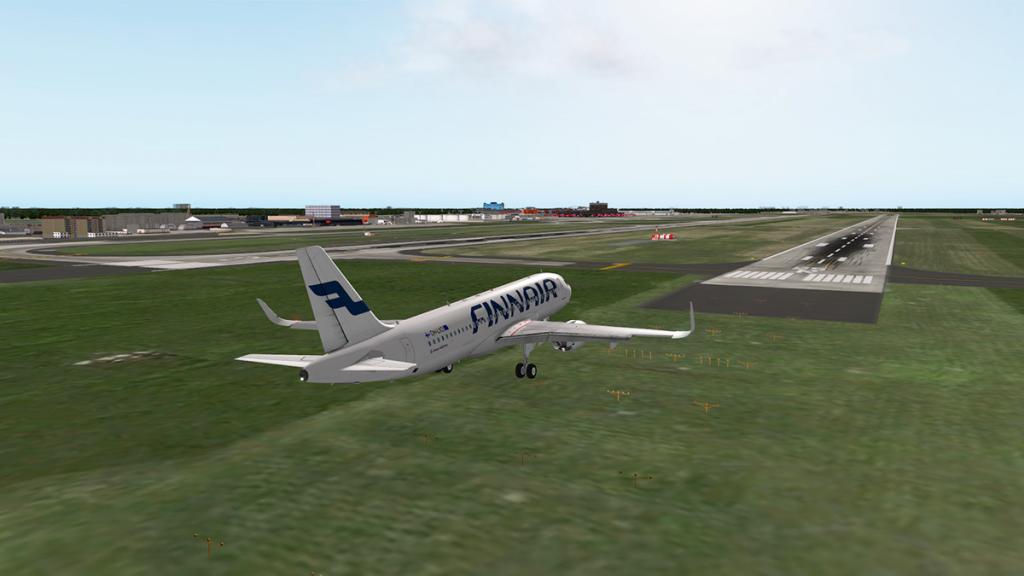
Sheremetyevo Airport
Before we move on to the city itself. It is important to note the area around UUEE Sheremetyevo itself.

Compare the large image above to the earlier image at the start of this review to see the amount of change there is around UUEE Sheremetyevo with the addition of this Moscow City package. The two sceneries are of course meant to be used together, and in reality it would look odd if you had Moscow City scenery installed without the Sheremetyevo scenery included to fill out the northern areas. A highlight is that both sceneries together form a single whole, as the areas between the airport and the central city area are well filled in and that gives you a huge area of coverage and the full visual aspect.
To get a closer lower look at the Moscow Center I commandeered Dreamfoil's lovely Bell 407.
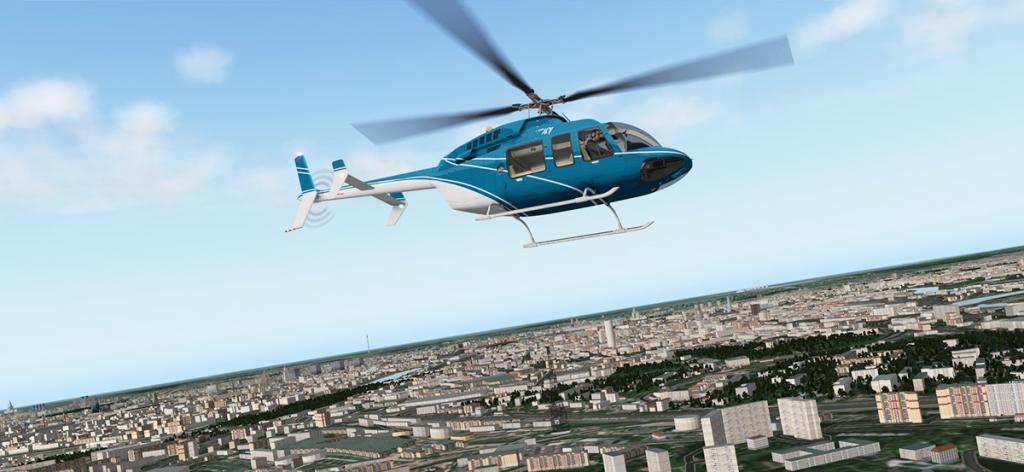
There is a 4.000km² total area covered with this scenery here, and you have expect some sort of building replication to cover all that ground. There is of course but as well in the fact there is also enough variations as to not keep it all interesting and not obviously visually obvious.
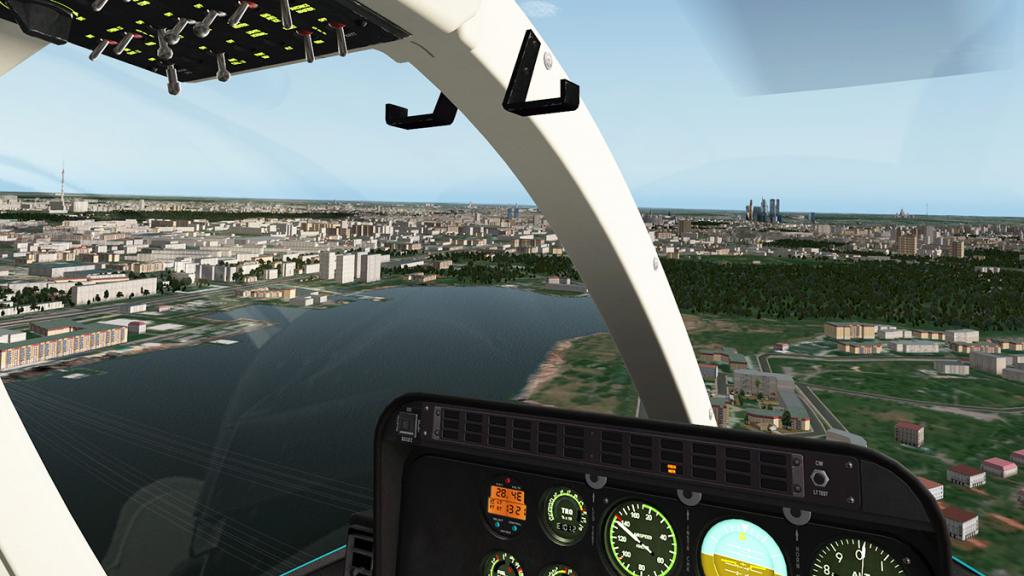
The closer you go to the central area, the variations in the buildings change there in style and density as well. And then more of the iconic buildings start to appear as you get closer in again to the middle. The business district is excellent, with a lot of business towers and the more modern futuristic skyscraper architecture that stands out in every view point in eye scans across the city.

The more recent is in tune with the more older Stalinist era that makes up the Moscow skyline.
The Kremlin Complex and the Cathedral of Vasily the Blessed (St Basil's) is excellently represented and so is "Red Square"
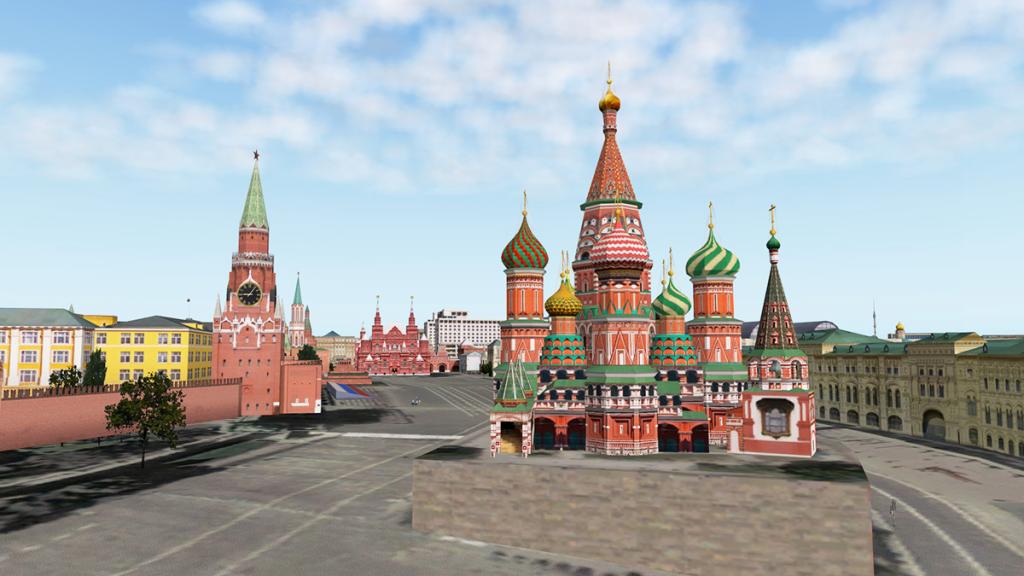
There are Orthodox churches everywhere and all the big icons in the Moscow Cathedral Mosque, Cathedral of Christ the Savior, Grand Arena of the Central Lenin Stadium, Otkrytive Arena and department stores, museums and power stations and more....
I did have issues with many buildings floating, including the Kremlin. I tried both "Runways follow terrain contours" on and off with no flattening of the objects and there is no information in the manual either on how to fix the problem.
Night lighting is very good, yes there is again a repeatable pattern to the majority of the hundreds of the apartment blocks that does stand out, but the more individual buildings do all have that personal touch and some buildings look really very good.

The highlight here is the business district which looks magnificent and is very realistic from any direction at night as is the lit Stadium.
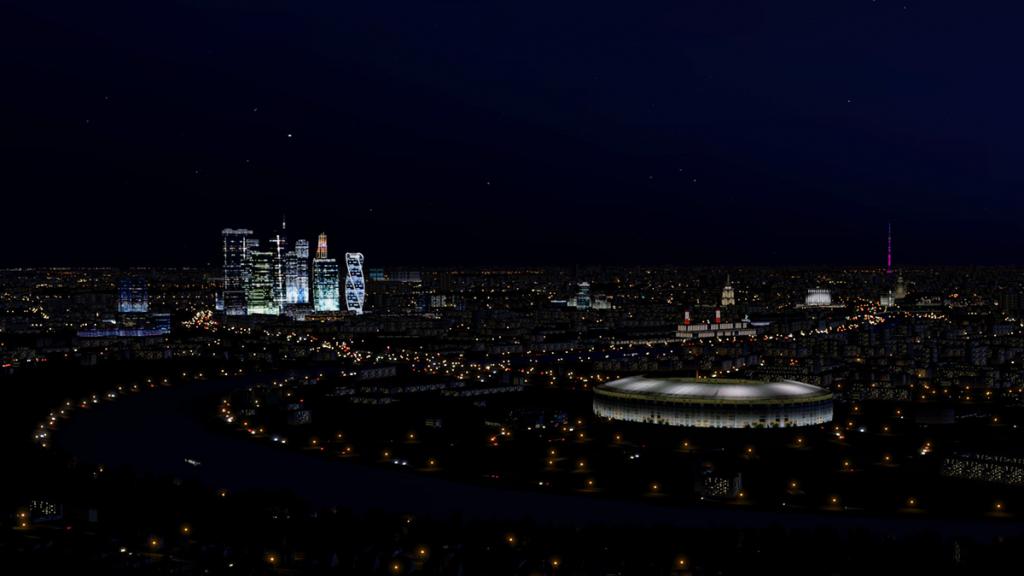
Although away from the central area the Ostankino Tower that stands 540.1 metres (1,772 ft) tall, and is the tallest freestanding structure in Europe and it looks great at night and is a very good position indicator from the air from any direction.
Included Moscow Airports
As noted also included in the scenery are seven airports and several helipads.
UUWW Vnukovo

The futuristic Vnukovo International is very good for a lite version, with great terminals and lots of small detailing. Only thing missing is the static aircraft and a bit more ramp equipment, but otherwise it is highly usable.
UUDD Domodedovo

The oldest of Moscow's International airports is Domodedovo. Again it is quite devoid of static aircraft and I am not crazy about the blue terminal glass work, but it is still a very workable scenery to use and has a lot of well made objects.
UUBW Zhukovsky

Zhukovsky was a major aircraft testing facility since the cold war years, with most of the major Russian Experimental Design Bureau's having facilities here. It is also now used by the Ministry of Emergency Situations! and cargo carriers. It was also used as a test site for the Soviet Buran reusable Spacecraft because it has the world's second longest pubic runway at at 5,402 m (17,723 ft). Mostly it is a collection of very large hangars but has a lot of static aircraft in storage.
UUMO Ostafyevo International Business Airport
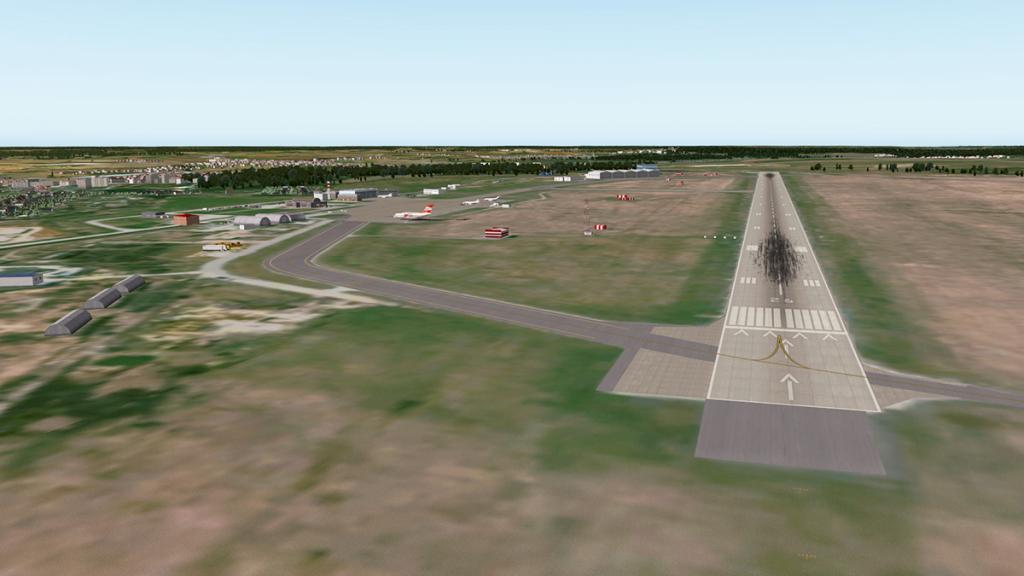
A former military airbase. Ostafyevo features a new modern glass terminal, and caters primarily to business aviation.
UUMU Chkalovsky

Chkalovsky is a military logistics airport that is famous for it's support for the Russian Space program and transport to Star City and the Yuri A. Gagarin State Scientific Research-and-Testing Cosmonaut Training Center. Yuri Gagarin left here on his final flight before crashing by the town of Kirzhach.
UUBM Myachkovo Airport
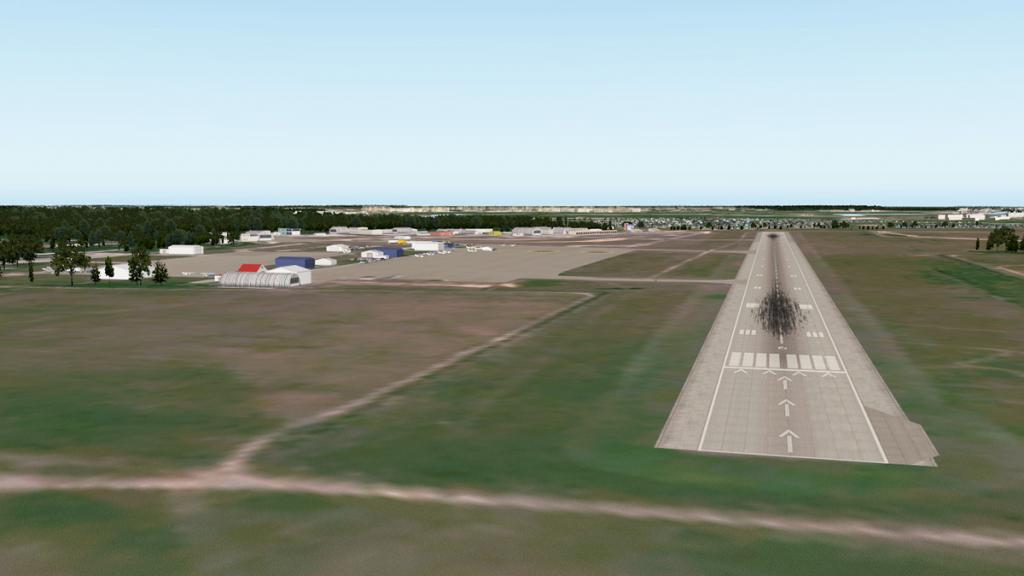
Myachkovo is a small General Aviation Airport that is owned by the Finpromko company. Cargo aircraft up to the size of the Ilyushin ll-76 freighter can also use the airport.
UUMB Kubinka

Kubinka has been a significant Russian military airbase and large airshows are held here to show off the Russian military might.
There is also provided UUU1 Kremlin Airport, within the Kremlin walls, but I couldn't get it to work? There are two pads in H1 and H2.
Your first thoughts after reviewing this excellent Moscow scenery is not with this actual package. You then wish that you could have this extensive scenery at London, Rome, Madrid, Berlin and the list could go on with any of your favorite European Cities, and don't count a load in the Middle East and Asia. But a London scenery like this would certainly be a godsend in our X-Plane world. Drzewiecki Design has already done Warsaw and Manhattan, so there is always hope.
It is not cheap either and you need to add in their UUEE Sheremetyevo scenery package on top of that as well. But you get an awful lot of ground covered here for your money, with the area covered here that is extensive... huge and flying into Moscow will never be the same again.
A few areas to note in one that in my case a few of the buildings floated, the download is huge load at 1.4gb and this Russian area is not the best for navigation aids and programming FMS units as most waypoints are not recognised. Most of the airports ILS coordinates also have to checked and recalibrated (Drzewiecki Design do provide all the correct coordinates) so there is a little work to do to set up repeat services but the work is worth the results.
Not only is the actual Moscow city and all it's buildings supported, you also get seven (if lite versions) of Moscow's other airports included as well, but the framerate processing of all this huge amount of objects and scale is pretty good to excellent. Framerate does hurt more on a lower (helicopter) level and certainly you need a computer with a little extra power is in no doubt required, but overall for the size of the area the scenery is extremely efficient.
Yes I was impressed by this Moscow City Scenery, as this once very barren area of X-Plane is now a very attractive repeat destination as nothing can give you a greater fulfilment than seeing your destination appear in the distance and then give you a huge visual experience as you fly over and approach your destination.
Moscow City certainly delivers that and more... Just more sceneries like this please!

Moscow City XP by Drzewiecki Design is NOW available! from the X-Plane.Org Store here :
- Extremely detailed model of Moscow metropolitan area in Russia
- Almost 2000 custom-made buildings and other objects, all high quality, FPS-friendly and with night textures
- Whole Moscow center done in 3D as well as all other important landmarks - museums, palaces, skyscrapers, towers, bridges, railway stations, Zara stores...
- Trains, ships, 3D people, cars, airport vehicles, static aircraft - anything you can imagine
- About 4000 sq.km of photoreal 0,5-1m/pix terrain with autogen
- Sceneries of all surrounding airports including UUWW Vnukovo, UUDD Domodedovo, UUBW Zhukovski, UUMO Ostafyevo, UUBM Myachkovo and UUMB Kubinka, with all airport buildings, detailed layouts, people, airport vehicles and more
- Very detailed Kremlin model with newly constructed heliport
Requirements
_____________________________________________________________________________________
Installation and documents:
Download for the Moscow City XP is 1.47gb and the unzipped file is deposited in the "Custom Scenery" as four files:
DDZ Moscow City XP (3.99gb) - Yes GIGABYTES!
DDZ Moscow City XP Layer 2 (30.20mb)
DDZ Moscow City XP Documents (1.0 mb)
ZZZ_DDZ Moscow City XP Terrain (20.10mb)
Installation for Windows comes with an .exe installer that deposits the files in the correct order required (however I still moved the ZZZ- folder to the bottom via the INI text install list.
Installation Instructions are provided for Mac and Linux
You need to check all airports ILS coordinates are correct, instructions are provided.
Documents: Two documents include
Moscow City XP MacLinuxinstall
Moscow City XP Manual (seven pages)
Review System Specifications:
Computer System : Windows - Intel Core i7 6700K CPU 4.00GHz / 64bit - 16 Gb single 1067 Mhz DDR4 2133 - GeForce GTX 980/SSE2 - Samsung Evo 512gb SSD
Software : - Windows 10 - X-Plane 10 Global ver 10.50
Addons : Saitek x52 Pro system Joystick and Throttle : Sound - Bose Soundlink Mini
Plugins: JARDesign Ground Handling Deluxe US$14.95 : WorldTraffic US$29.95
Scenery or Aircraft
- Airbus A320neo by JARDesign ( X-Plane.OrgStore ) - US$59.95 : A320neo Sound Packs by Blue Sky Star Simulations ( X-Plane.OrgStore ) - US$19.95
- Bell 407 by Dreamfoil Creations ( X-Plane.OrgStore ) - US$34.95

Link to comment
Share on other sites.
- 7 months later...

Thank you for this very thorough (as always) review. I just bought it (it's on sale) and have only one disappointment so far: Red Square has no ILS or any landing aids at all for that matter. And what a nightmare of an approach! Also I was hoping the package would include an add-on that gives my c172 a big cup holder for my Stoli. Otherwise the scenery is gorgeous. What a country!
Join the conversation
You can post now and register later. If you have an account, sign in now to post with your account. Note: Your post will require moderator approval before it will be visible.

× Pasted as rich text. Paste as plain text instead
Only 75 emoji are allowed.
× Your link has been automatically embedded. Display as a link instead
× Your previous content has been restored. Clear editor
× You cannot paste images directly. Upload or insert images from URL.
- Insert image from URL
- Submit Reply
Recently Browsing 0 members
- No registered users viewing this page.
- Existing user? Sign In
- General Aviation
- Helicopters
- Classic Aircraft
- Plugins/Apps and Simulator Addons
- Behind The Screen
- Forums Index
- Create New...

IMAGES
VIDEO
COMMENTS
The weight required to sink the yacht one inch. Calculated by multiplying the LWL area by 5.333 for sea water or 5.2 for fresh water. FOR MULTIHULLS ONLY: BN - Bruce Number: The Bruce Number is a power-to-weight ratio for relative speed potential for comparing two or more boats. It takes into consideration the displacement and sail area of ...
Broker's comments. OE 32, a beautiful S-shaped canoe stern Danish sailing yacht, designed by Olle Enderlein. A yacht with great maneuverability in the smallest port or near shores due to her draft of 1,50 m. Easily handled by the smallest crew under practically all weather conditions, even solo. Engine of 2011, paintjob hull 2012.
The fifth finisher in the 2022 Golden Globe Race, Jeremy Bagshaw shares how he prepared his OE32 for a non-stop circumnavigation alone. At 32ft, Olleanna was the smallest boat in the 2022 Golden Globe Race fleet, but had the second longest waterline and was one of just five boats to finish. Credit: GGR2022/DD&JJ Credit: GGR2022/DD&JJ.
List it for free and it will show up here. OE 32 is a 32′ 5″ / 9.9 m monohull sailboat designed by Olle Enderlein and built by Sundsör's Ship Yard (SWE)/Eggers (GER) between 1973 and 1983.
OE 32. Built: 1983. Material: GRP. Dimensions: 9,89 x 3,18 x 1,50 m. Sold in: 2014. OE 32, a beautiful S-shaped canoe stern Danish sailing yacht, designed by Olle Enderlein. A yacht with great maneuverability in the smallest port or near shores due to her draft of 1,50 m. Easily handled by the smallest crew under practically all weather ...
Immersion rate. The immersion rate is defined as the weight required to sink the boat a certain level. The immersion rate for OE 32 is about 178 kg/cm, alternatively 1002 lbs/inch. Meaning: if you load 178 kg cargo on the boat then it will sink 1 cm. Alternatively, if you load 1002 lbs cargo on the boat it will sink 1 inch.
General - OE 32. OE32 "Zuidwester", built in 1983 by Sundeved Yachtvaerft in Sonderborg - Denmark, designed by Olle Enderlein, dim.: 9,89 m (Lwl 8,40 m) x 3,18 m x 1,50 m, GRP hull, superstructure and deck, teak railinga and teak details on deck, 3x Gebo hatches, S-shaped hull, displacement: 5,8 tonnes, fuel tank: 40 litres, fresh water: 225 ...
200 units have been built. The Oe 32 is a moderate weight sailboat which is slightly under powered. It is very stable / stiff and has an excellent righting capability if capsized. It is best suited as a bluewater cruising boat. The fuel capacity is originally small. There is a short water supply range.
Try a new search. Browse power boats and sailing boats by manufacturer. Create a Boat Alert to have matching boats emailed to you when they are added. Search all our new or used OE 32 for sale. We have OE 32 brokers and sellers from around the world at great prices. Used OE 32 for sale from around the world. Search our full range of used OE 32 ...
Olle Enderlein designed and built the first OE32 for himself and this one went on to be built by the shipyards of Ulrich Lemke at Sundeved's Yacht Builders in Sønderborg, Denmark. The OE32 is a classic long-keeler for long voyages, the whole boat is a well-proportioned and timeless beauty.
Used Boat, Sailing Yacht. OE32. Save as favorite. EUR 33,525; apx. £ 29,600; 1987 Year Built; 9.89 m x 3.18 m Length x Beam; 1.50 m Draught; 58 kg Displacement; GRP Material; Mitsubishi 32 HK Engine; Location. ... OE32. EUR 33,525. 1987. YachtBasen ApS. Dealer from Denmark. Verified Seller. Dealer on Boat24 for more than 6 years. Møllegade 10 ...
Boats for sale - 16,073 ads. Sellers and buyers meet on "Boats for sale".It is possible to search more than 14.000 boats from across Europe. Once you have made your searches and are logged in, you have the option to save your search for a boat and create an ad agent. Then you will automatically be informed when your dream boat is for sale on scanboat.
Beautiful S-shaped, canoe stern OE 32 "Lorbas", designed by Olle Enderlein, a yacht with great manoeuvrability in the smallest port or near shores due to her draft of only 1.50 m. Easily handled by the smallest crew under practically all weather conditions. Bukh DV36 36 hp diesel engine of 1997.
Sail World - The world's largest sailing news network; sail and sailing, cruising, boating news
Join Date: Mar 2011. Location: Southport CT. Boat: Sabre 402. Posts: 2,638. Re: OE32. Being eligible for the Golden Globe Race does not mean a boat is necessarily well-suited for ocean sailing. It means it is an old design. That was one of the criteria for acceptable entries. Newer boats need not apply.
This vessel was designed and built by the OE shipyard in 1988. Key features 1988 OE 32: length 9.89 meters, beam 3.18 meters, boat displacement 6,100 kilograms and max boat draft 1.55 meters. Hull key features 1988 OE 32: hull material - fiberglass. 1 x leyland engine: fuel type - diesel. 1988 OE 32 refers to classes: powerboats.
Used Boat, Sailing Yacht. OE32. Save as favorite. EUR 26.820,-1987 Year Built; 9.89 m x 3.18 m Length x Beam; 1.50 m Draught; 58 kg Displacement; GRP Material; Mitsubishi 32 HK Engine; Location. Denmark. Comments 1987 OE32, EUR 26.820,-NOTE! NEW VERY ATTRACTIVE PRICE! OWNER IS MOTIVATED FOR SALE AND THE BOAT IS SOLD AS IT IS! If you are looking ...
Dress code & Face control. Door policy in Moscow is called "face control" and it's always the guy behind the two gorillas that gives the green light if you're in or out. In Moscow nightlife there's only one rule when it comes to dress codes: You can never be underdressed. People dress A LOT sharper than, say, in the US and that goes ...
BROKER'S COMMENTS. ''OE 32, a beautiful S-shaped canoe stern Danish sailing yacht, designed by Olle Enderlein. A yacht with great maneuverability in the smallest port or near shores due to her draft of 1,50 m. Easily handled by the smallest crew under practically all weather conditions, even solo. Engine of 2011, paintjob hull 2012.''.
Installation and documents: Download for the Moscow City XP is 1.47gb and the unzipped file is deposited in the "Custom Scenery" as four files: . DDZ Moscow City XP (3.99gb) - Yes GIGABYTES! DDZ Moscow City XP Layer 2 (30.20mb) DDZ Moscow City XP Documents (1.0 mb)
The weight required to sink the yacht one inch. Calculated by multiplying the LWL area by 5.333 for sea water or 5.2 for fresh water. FOR MULTIHULLS ONLY: BN - Bruce Number: The Bruce Number is a power-to-weight ratio for relative speed potential for comparing two or more boats. It takes into consideration the displacement and sail area of ...
Here's an F2 onboard lap at the Autodrom Moscow in Moscow, Russia. This hotlap is driven in Assetto Corsa with Robert Shwartzman in the F2 2020 car, using th...
Buy tickets. River Cruise aboard a River Palace Yacht from City-Expocentre (International Exhibition) HIT SALES. Daily, from April 27, 2024. Departure from the berth City-Expocentre (m. Vystavochnaya), mooring place "A". Cruise duration 3 hours. We invite you on a river cruise aboard a premium class panoramic yacht starting from the main Moscow ...